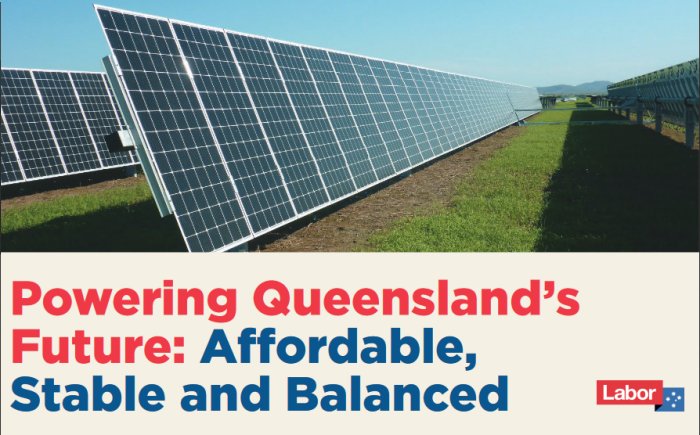
Advancing solar energy in Queensland will remain an important focus under a re-elected Palaszczuk Government.
Yesterday, Queensland Labor released its Powering Queensland’s Future policy document, which includes commitments for solar on schools, in remote communities and cash for large-scale solar thermal power.
“Only my government has a plan to power Queensland’s future with the right energy mix – a balance of renewables & our current fleet of generation,” said Premier Anna Palaszczuk. “That’s why I’m proud to announce today a $151.6 million commitment to support new large scale renewable generation and solar in schools.”
A re-elected Palaszczuk Government will commit $40 million for 35 MW of solar PV generation on school rooftops, with more than 800 public schools to benefit from the investment. Labor says the initiative would slash more than more than $10 million in energy costs each year for Queensland state schools, which are among the government’s largest energy consumers.
The plan for schools also includes $57 million to be invested in energy efficiency measures.
Queensland Labor has also pledged to commit up to $50 million in capital funding towards the development of a concentrated solar thermal plant with storage in the state.
“Importantly, a new solar thermal power plant will mean manufacturing and operational jobs in the regions,” says the policy document. “It also means that Queensland will be able to start running on solar power even at night – truly turning the Sunshine State into the Solar State.”
Another commitment is the creation of a third publicly-owned power generation company called CleanCo, which will have a mandate to deliver 1,000MW of new renewable energy projects for the state by 2025. This will involve restructuring Queensland’s two publicly-owned electricity generation companies into three.
“CleanCo will initially own a strategic portfolio of low and no emission electricity generation assets which will be aimed at bringing down electricity prices by incentivising the company to deploy its generation assets, and add competition to the market, at those peak demand times when electricity prices are the highest,” states Queensland Labor.
Under the Jobs and Regional Growth Fund, more solar PV and other clean energy solutions will also be rolled out in remote and isolated communities currently relying on diesel generation.
With regard to the Federal Government’s proposed National Energy Guarantee (NEG), Queensland Labor says it won’t agree to any policy until it is fully fleshed out – and in the best interests of the state.
The Powering Queensland’s Future (PDF) policy document can be downloaded here (PDF).
It’s not all sunshine and puppies for the Palaszczuk Government. The shadow of Adani looms large over this election – and there are 56 billion reasons why Adani’s Carmichael coal mine should not go ahead.
LNP To Scrap Target, Build More Coal Power
Queensland currently has a target of 50% renewable energy by 2030, a target the LNP has vowed to scrap if it gains power. The LNP has also committed to building a high-efficiency, low emissions (HELE) coal-fired power station in North Queensland that it says will boost energy security and lower wholesale electricity prices.
“HELE” is a rather optimistic acronym as HELE power stations aren’t all that much more efficient, only marginally reduce toxic emissions and aren’t much better in relation to CO2 emissions than conventional black coal plants.
The Energy Security Board’s Kerry Schott acknowledged in a webinar on Friday HELE plants are “actually very expensive per megawatt.”

 RSS - Posts
RSS - Posts



In the above report, is
”
A re-elected Palaszczuk Government will commit $40 million for 35 MW of solar PV generation on school rooftops, with more than 800 public schools to benefit from the investment. Labor says the initiative would slash more than more than $10 million in energy costs each year for Queensland state schools, which are among the government’s largest energy consumers.
”
I am curious about how that proposal compares both with what exists, and, with what proposed, in the other states/territories of Australia.
With the content in the report;
”
Queensland currently has a target of 50% renewable energy by 2030, a target the LNP has vowed to scrap if it gains power. The LNP has also committed to building a high-efficiency, low emissions (HELE) coal-fired power station in North Queensland that it says will boost energy security and lower wholesale electricity prices.
“HELE” is a rather optimistic acronym as HELE power stations aren’t all that much more efficient, only marginally reduce toxic emissions and aren’t much better in relation to CO2 emissions than conventional black coal plants.
”
and, the content in the report published at
https://www.solarquotes.com.au/blog/india-delhi-pollution-mb0296 ;
”
With regard to coal specifically, it has been reported to be responsible for an estimated 80,000 to 115,000 premature deaths in India annually.
”
I wonder how many premature deaths are attributable to each ton of Australian coal that is burnt, and, how many premature deaths are attributable to each MWh of electricity generated from burning coal; and, thence, as a third and separate number, how many premature deaths are intended to be caused by the policy of the Queensland LNP as stated.